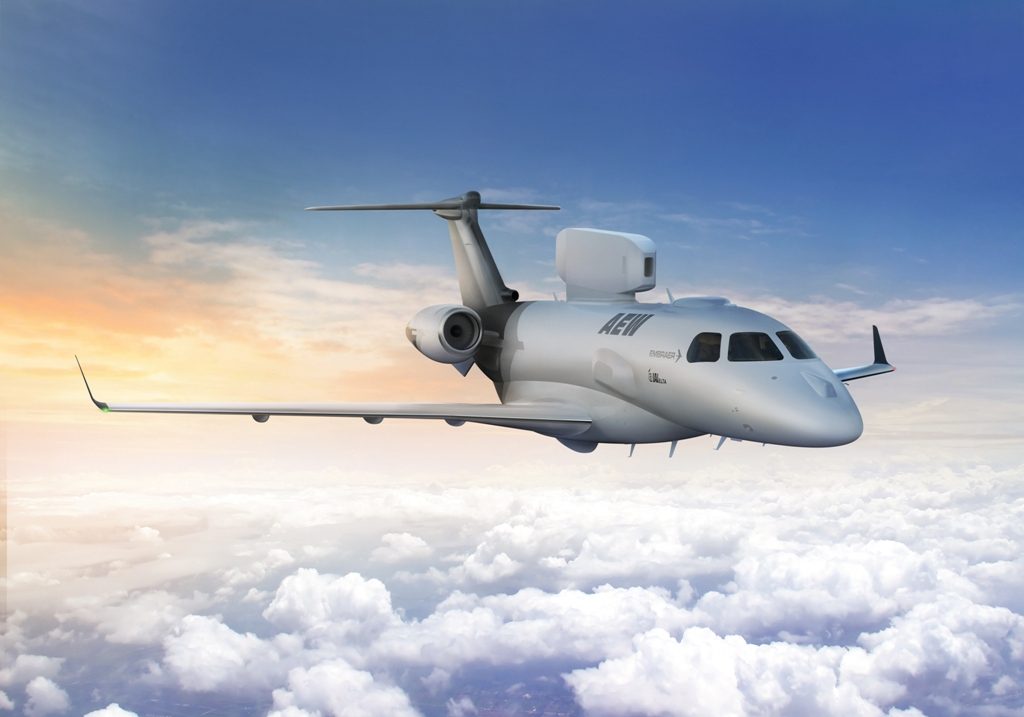
PAS19: Embraer and IAI cooperate on an affordable AEW solution
Until today cost has been one of the limiting factors in the acquisition of airborne early warning (AEW) aircraft. For many countries the proposed solutions were unaffordable in terms of acquisition costs, although the need of ensuring full airspace coverage was a priority.
This paradigm was changed by the strategic cooperation agreement signed on June 18, 2019 in Paris by Embraer and Israel Aerospace Industries (IAI). The two companies will develop the AEW version of the recently introduced P600 Praetor fitted with an IAI/ELTA 4th generation Digital Active Electronically Scanned Array (AESA) radar with integrated IFF capabilities.
Embraer Defense & Security will provide the air platform, ground support, communications systems and aircraft integration while ELTA is to provide the AEW radar, SIGINT (Signals Intelligence) and other electronic systems and system integration.
The Brazilian aeronautical company acquired an experience in special mission aircraft with the different versions of its EMB-145, while IAI has developed AEW and intelligence solutions mostly based on Gulfstream platforms.
“Radar miniaturisation is allowing reducing AEW platforms dimensions,” IAI representatives tell EDR On-Line, explaining that the new tiles technology adopted by the company, which brings 16 or 32 radar modules to be put on the same tile, allows a significant reduction in dimensions and weight, the latter decreasing by an order of magnitude. This also allows reducing the radar cost, the weight and dimensions saving permitting the choice of a smaller platform, which led to the choice of the P600. With a 21.5 meters wingspan, this eight passengers executive jet can fly at up to 45,000 ft carrying over 1,800 kg payload, with a range of over 7,400 km. It is powered by two Honeywell HTF750 engines providing 7,528 lb thrust which allow it to reach a maximum speed of Mach 0.83, “an important issue when the AEW aircraft must reach the operational area in the shortest possible time,” IAI officials underline. Its capacity to reach 40,000 ft, the usual operational altitude, in less than half an hour is also much appreciated.
The P600 will be fitted with an S-band ELM-2096 long range radar that will be contained in a pod installed over the aircraft, “modification being however much less dramatic than those required in our Gulfstream-based AEW aircraft,” IAI experts say. The ELM-2096 earmarked for the P600 is the very latest product of IAI Elta and is being optimised for being installed on the Embraer aircraft, this latest configuration being in advanced state of development. The ELM-2096 will provide a 240° coverage, 120° on each side, the AESA antenna scanning ±60° per side. This means that depending on the mission the P600 AEW will fly an optimal pattern to cope with the required coverage. According to IAI it is not only a true long range radar, but it also features ultra-high probability of discovery and ultra-low false alarm rate. Identification friend-or-foe as well as electronic support measures are also part of the aircraft suite. The internal layout will be made of three operational workstations, a comprehensive communication suite including data networks and satellite links, and a robust self-protection suite. Direct LOS and SATCOM links have sufficient throughput to relay all data on the ground, the P600 AEW being also capable to command and control
Although price will very much depend on the configuration, EDR On-Line was told that “the cost should be less than half that of equivalent solutions.”
The P600 being is last generation biz-jet, and could be seen during the Paris Air Show flight display, first deliveries being planned by year-end. The trend being reducing operational costs, the Praetor flight hour will definitely be less expensive than that of current AEW solutions, also thanks to its reduced dimensions, which adds to the P600AEW competitiveness.
This, according to both Embraer and IAI, will open up a wholly new market segment in the airborne AEW market, allowing smaller countries to equip their air forces with systems providing full coverage of the most critical areas at affordable acquisition and operational cost.
Photo courtesy Embraer/IAI



